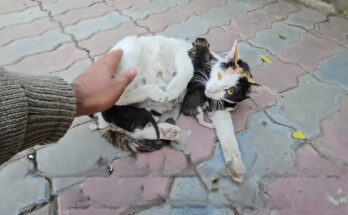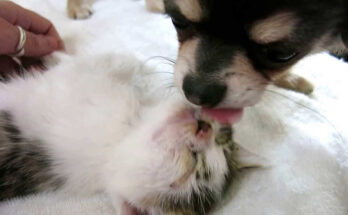The paint-covered stray cat slowly walked toward the girl, trying to get help. Its thin frame trembled with each step, matted fur clinging to its fragile body. Bright streaks of blue, red, and yellow paint stained its coat, as though it had fallen into an artist’s palette. The late afternoon sun cast golden light over the alley, catching the girl’s attention as she sat on the curb, tying her shoe.
She looked up and gasped. “Oh no, what happened to you?” she whispered.
The cat let out a soft, hoarse meow—more a plea than a sound. It stopped just short of her, wary yet desperate. The girl, maybe twelve years old, slowly extended her hand, crouching low.
“I won’t hurt you,” she said gently. Her name was Emily, and she’d always had a soft spot for animals. She noticed the cat’s limping front paw, the way it winced as it shifted its weight. Someone—or something—had clearly mistreated it.
“I think you need help,” Emily said softly.
The cat blinked at her, as if to say, I know.
With careful patience, Emily scooped the cat into her arms. It didn’t fight. Instead, it leaned into her, exhausted and defeated. The paint left colorful blotches on her sweater, but she didn’t care.
At home, Emily filled a basin with warm water and gently cleaned the cat’s fur. Bit by bit, the paint washed away, revealing patches of orange and white underneath. Her parents watched, surprised, but allowed her to care for it.
Over the next few days, Emily fed the cat, talked to it, even sang to it. The cat—now named Lucky—began to purr, its trust slowly returning.
Lucky had once asked for help the only way it knew how: by walking up to someone kind. And Emily, hearing that silent question, had answered without hesitation.
Sometimes, the smallest cries for help are the ones that need answering the most.



